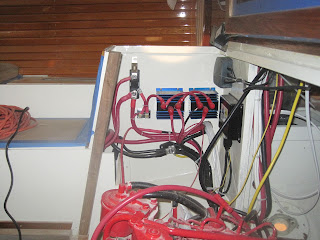Material List
Two lowers 80 ft 5/16 stainless steel wire
2 ea 5/8 inch turnbuckles
4 ea 5/8 inch toggles
4 Hayn 5/8 Hi mod terminals
Two Cap Shrouds
100 ft 1/4 inch stainless wire
2 ea 1/2 inch turnbuckles
4 ea 1/2 inch hi mod Hayn terminals
2 ea 1/2 inch double jaw toggles (at top)
Fore Stay
50 ft. 5/16 inch stainless wire
1 ea 5/8 inch turnbuckle (top)
1 ea 5/8 inch jaw to jaw toggle
2 ea 5/8 inch hi mod terminals
Bow Sprit Shrouds
40 feet 5/16 inch stainless wire
2 ea 5/8 in turnbuckles
4 ea 5/8 inch toggles
4 Hayn 5/8 Hi mod terminals
Back Stays
80 feet 9 mm Dyneema
½ inch jaw to eye toggle
2 ea Colligo chain plate distributor ½ inch
Lashing x 2
2 ea ½ inch Colligo line terminators
Running Back Stay Tackle (4 to 1 )
1 ea 3.5 inch double block with fork connector
1 ea 3.5 inch single block with becket
1 each Colligo static block
2 ea ½ inch eye to jaw toggle
2 ea Diamond Deck chainplate w ½ inch eye for clevis pin
120 ft 3/8 inch Novabraid
2 web strops with D rings
2 tufnol snatch blocks
Head Stay
60 ft 9 mm Dyneema with leathered loop
1 ea ½ inch Colligo line terminator
Lashing
1 ea ½ inch chainplate distributor
eye to jaw toggle ½ inch
Spinnaker Halyard and Block
Ording 3.5 inch strop (long) block on thimble
1 ea Colligo soft eye shackle
Leathered loop around mast
100 feet 3/8 inch Novabraid belayed to pin rail
Jib Halyard (dinghy hoist)
150 feet 7/16 inch “Vectran V-100 braid ”
1 ea 4 inch block with an upset shackle connector. (on top band)
1 ea 4 inch block with snap shakle ( on sail, load)
2 eye jaw toggles (one on each collar to allow p&and movement)
Colligo C-5 Furler with stainless swivel
Thimble and shackle (for dead end of line to lower band)
Peak Halyard
160 feet of 7/16 inch Novabraid
2 ea 4 inch blocks with front shackle connectors
1 ea 4 inch block on spanhook connector
Gaff span ¼ inch wire thimballed to grommet
Throat Halyard
120 feet of 7/16 inch Novabraid
1 ea 4 inch single block with a becket on a fork (lower block)
1 ea 4 inch double block with a fork or eye connector (hang from crane)
2 ea jaw to eye toggles ( just in case)
Top Sail Halyard
120 feet of 3/8 (sheave size?) inch Vectran V-100 Braid
Bronze snap shackle spliced on
Stay Sail Halyard (Dinghy Hoist)
60 feet of 7/16 inch Novabraid
1 ea 4 inch strop block
1 ea bronze snap shackle
Main Sheet
106 feet of 7/16 inch New England Regatta Braid
2 swivel deck plate singles with cam cleats
1 non-rotating deck plate single
1 ea double block w/ eye connector
Jib Sheets
125, 100, 100 and 100 ft sheets 7/16 Novabraid
2 deck bulls eyes or 2 snatch blocks on web strop with D ring
Stay Sail Sheets
106 feet 7/16 Novabraid
2 ea 4 inch blocks on rail
Top Sail Sheet
1 ea Bronze Block
60 ft 3/8 inch Novabraid
Bowsprit Traveller
40 ft 3/8 inch Novabraid
Bronze block on cranes iron
Topping Lifts
70 ft. 9 mm Dyneema
2 ea Colligo 11 to 13mm static single blocks on multiplied strops attached to eye bolts.
2 ea line terminators
Topping lift tackle
2 ea fiddle blocks with fork and becket (Top one pinned to line terminator)
100 feet 7/16 inch Novabraid falling from top to pin rail at bulwarks
2 ea fiddle blocks with fork connector to toggle
2 ea soft eye shackles ( to shroud to keep block from swinging )
2 eye jaw toggles (one on each chain plate)
Sail luffs
Working jib, Yankee, Storm and Drifter 200 ft of Dyneema
Life Lines
2 Colligo life line kits with gates but use 9mm instead of 5mm
Totals by Vendor
Ording Blocks, Unfinished Teak
2 ea 3.5 inch fiddle blocks with fork connector
2 ea 3.5 inch fiddle blocks with cam cleats with ½ fork connector
1 ea 3.5 inch strop (long) block on thimble
1 ea 4 inch block with an upset shackle connector (on top band)
1 ea 4 inch block with snap shackle ( on sail, load)
2 ea 4 inch blocks with front shackle connectors
1 ea 4 inch block on spanhook connector
1 ea 4 inch single block with a becket on a fork (lower block)
1 ea 4 inch double block with a fork or eye connector (hang from crane)
1 ea 4 inch strop block
2 swivel deck plate singles with cam cleats
1 non-rotating deck plate single
1 ea double block w/ eye connector
2 ea 4 inch blocks on rail
2 ea fiddle blocks with fork and becket (Top one pinned to line terminator)
2 ea fiddle blocks with fork connector to toggle
230 ft 5/16 inch stainless wire
Hayn
5 ea 5/8 inch turnbuckle
8 eye to jaw 5/8 inch toggles
1 jaw to jaw 5/8 inch toggle
10 ea 5/16 inch hi mod terminals
2 ea ½ inch turnbuckles
4 ea 1/4 inch hi mod Hayn terminals
2 ea 1/2 inch double jaw toggles
12 ea ½ inch eye to jaw toggles
Novabraid
340 ft of 3/8 inch Novabraid XLE
975 ft of 7/16 inch Novabraid
New England
106 ft7/ 16 inch Regatta braids
120 ft of 3/8 inch Vectran V-100 Braid
150 ft 7/16 inch Vectran V-100 Braid
Lashing line
Colligo
3 ea ½ inch chain plate distributors
5 ea ½ inch line terminators
C-5 Furler with swivel
510 ft 9mm Dyneema includes sail luffs and lifelines
6 soft eye shackles
2 11-13 mm static blocks
Misc
5 ea bronze snap shackle
2 deck mount bulls eyes
2 diamond deck chain plates
4 web strops with D rings





























































